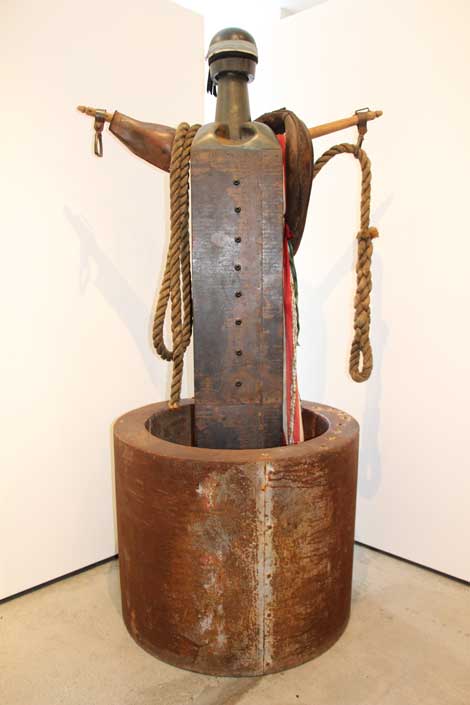While the exhibition’s title immediately triggers images of wild head-bangin’ rockers wailing away at unheard of decibels, for five African-American abstract sculptors it was a call in response to the use of metal in their work, guided by ancestral memory and tapping into the depths of the collective subconscious of the culture of Ogun. Jill Moniz is to be applauded for her curatorial savvy in finding a woman sculptor, Maren Hassinger, and introducing the work of Joseph Beckles (1951-2005) to a larger audience. However, the absence of John Riddle’s work is problematic.
Two sculptures, Link (2004) and Twirl (2005), provide a solid introduction to Beckles’ oeuvre, beginning his career as a wood carver—later turning to metal. Twirl tracks the movement and afterimage of an object twirling in space, while Link’s politically charged and psychologically intimidating material, i.e. chains, suggests that even though we come from different backgrounds, we are connected by intertwining histories and common destinies.
Throughout the majority of her career, Hassinger has deconstructed wire cable, by unweaving, unraveling and untangling its tight ends into reconfigurations that reveal formal possibilities, and invoke deeper meanings. Her “industrially unbraided” cable ends recall the tips of Ethiopian women’s hair-dos, or the exposed root systems of Baobob trees, poetically captured in When The Time Came There Were No Leaves (1988). The work is composed of a pair of maquettes evoking wind blown tree branches stripped of their foliage. Hassinger’s wall sculpture, Weaving (1973-2013) offers further information concerning her “de-weaving/re-weaving” of spliced cable and echoes certain Taureg geometries. Her “re-woven” excursions share a broader affinity to El Anatsui, and Barbara-Chase Riboud.
The welded pieces on the surface of Mel Edward’s disc-shaped relief, Homage to James Benjamin Edwards (1964) are a personal family encryption to his grandfather that operate as an ancestral veneration offering. The placement of the welded parts is governed by a Monk-like (as in Thelonious) order of random distribution, revealing its own heavy metal timbre, exhibited next to a disc-shaped companion piece, the visually introverted Hemet (circa 1960).
User Friendly (2010) by Charles Dickson is an intriguing mask form, which poignantly comments on the lingering effects of the oil crisis on the environment by successfully employing a mantra of the 3 R’s: reclaim, recycle and reuse of discarded and obsolete auto parts, gone haywire from a previous era of “planned obsolescence.” Dickson’s quintessential heavy metal statement is his monumental work Wish Upon A Star (2009), stationed at California African American Museum’s entrance.
One detects a bit of irony in John Outterbridge’s In Search of the Missing Mule (1992). It echoes the rhetorical question, “Where is my 40 acres and a mule?” Those familiar with African-American folklore immediately recognize that no mule or its accompanying 40 acres was forthcoming, as reparations for freed blacks. Vertical (1994) reads like a recently discovered urban artifact, excavated from an inner-city dig. The surface is tattooed with partially nondescript markings that suggest a form of “community speak,” while the rest of the piece takes on a life of its own.


